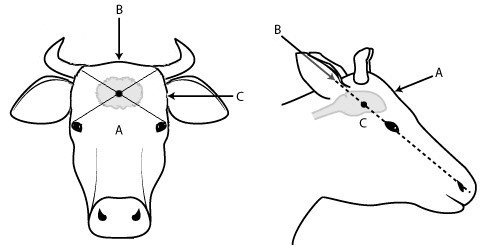Slaughter
Before arriving at the slaughterhouse, cows are cramped onto trucks and transported vast distances without food or water. 48 hours without water is considered acceptable according the DAFF's (Department of Agriculture, Fisheries and Forestry) 'Animal Welfare, Standards and Guidelines for Land Transport of Livestock', however these standards or guidelines are not monitored in any meaningful way.

In Australia, after coming off the truck and being left overnight in often cramped holding pens, cows are then further traumatised by being forced down the 'race' and into the knockbox, often with the use of electric prodders or physical aggression, where they are shot in the head with a captive bolt gun or firearm. Performed correctly, this should render the cow unconscious and cause irreversible brain damage to the animal. Alternative non-skull-penetrating guns are also used in some slaughterhouses, which instead will cause concussion before unconsciousness. The cow will then have their throat slit before being hung upside-down, the blood draining from their body. For cattle live-exported overseas, they are often killed in far slower, more agonising ways.
It should be noted that there have been many documented cases where the cow remains conscious as their throat is slit. When Farm Transparency Project investigated 30 Australian slaughterhouses across 2023-2024, we found that cows would commonly remain conscious, even after being shot multiple times and after having their throats slit. Further, more than a dozen slaughterhouses in Australia have government approval to slit the throats of fully-conscious cows to satisfy the religious practices of 'halal' and 'kosher' slaughter.
%20Cam%209%20-%20Cattle%20tipout.00_31_01_22.Still003.jpg)
%20-%202024-01-17.00_11_22_17.Still001.jpg)
Business Queensland establishes the following methods for the 'humane killing of cattle.'
Frontal method - suitable for firearm or captive bolt
Aim the firearm at the point of intersection of lines taken diagonally from the top of each ear to the inside corner of the opposite eye (position A).

Poll method
The poll method is not recommended for cattle. Only use the poll method if accessing the frontal position is not possible.
The animal is shot from above (position B) mid-way between each ear with the direction of aim down towards the muzzle of the animal.
Temporal method - suitable for firearm only
The animal is shot from the side so that the bullet enters the skull midway between the eye and the base of the ear on the same side of the head (position C). The bullet should be directed horizontally.
The temporal position should only be used if frontal position is not possible.
Note: Stunning (by captive bolt) does not necessarily result in death. Bleeding out must be carried out immediately to ensure death occurs.
Blunt trauma
The use of blunt trauma on newborn young calves less than 24 hours old must immediately be followed by bleeding out, while the animal is unconscious, to ensure death.


